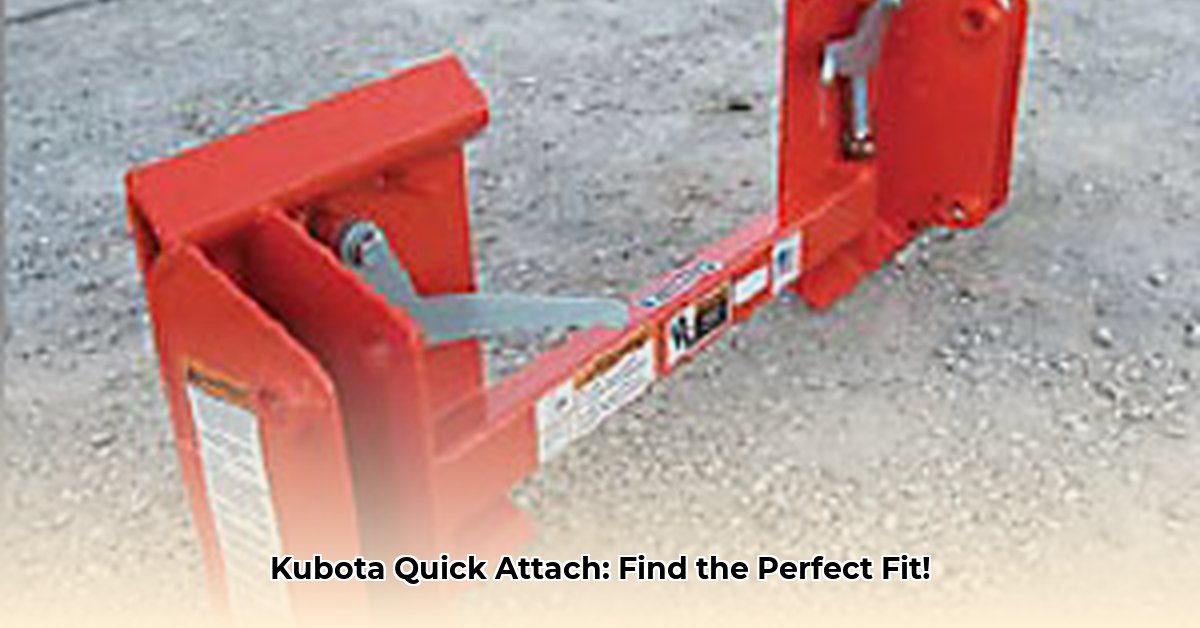
Identifying Your Kubota Loader Model: The Crucial First Step
Before you begin your search for a Kubota quick attach system, accurately identifying your loader model is paramount. This seemingly small step is the foundation for ensuring compatibility and avoiding costly mistakes. The wrong quick attach can lead to inefficient operation, potential damage to your tractor, and even safety hazards. For additional resources on Kubota attachments, check out this helpful website.
Locating Your Model Number:
- Visual Inspection: Begin by meticulously inspecting your Kubota loader for a data plate or sticker. This plate typically displays your loader's model number—a unique alphanumeric code—and is often located on the loader's frame or near the control levers. Take a clear photograph for future reference.
- Owner's Manual Consultation: Your owner's manual serves as a comprehensive guide for your tractor. Refer to the relevant sections detailing specifications and compatible attachments. Your model number should be clearly stated within the manual.
- Kubota's Online Resources: Kubota provides extensive online resources, including parts lookup tools. By entering your tractor's model number (often found on a sticker on the tractor itself), you can access detailed information about compatible quick attach systems.
Researching Compatible Quick Attach Systems: Genuine Kubota vs. Aftermarket
With your Kubota loader model identified, you can now explore the available quick attach options. You'll primarily find two choices: genuine Kubota parts and aftermarket alternatives. Each presents a unique set of advantages and disadvantages.
Genuine Kubota Quick Attaches:
- Pros: Guaranteed compatibility, superior build quality, comprehensive warranties, and often better resale value.
- Cons: Higher initial cost compared to aftermarket options.
Aftermarket Quick Attaches:
- Pros: Often more affordable than genuine Kubota parts, potentially offering a wider range of choices.
- Cons: Variable quality; thorough research is essential to ensure compatibility and durability. Warranty coverage may also be less comprehensive.
Checklist for Choosing a Quick Attach:
- Manufacturer Reputation: Research the brand's history and customer reviews.
- Warranty: A strong warranty demonstrates the manufacturer's confidence in their product.
- Material Quality: Prioritize durable materials such as high-strength steel.
- Customer Reviews: Seek out independent reviews to gauge real-world performance and longevity.
- Compatibility: Always double-check compatibility with your specific Kubota loader model.
Purchasing and Installation: A Safe and Efficient Process
After selecting a quick attach, purchase from a reputable supplier known for quality products and reliable customer service. Safe installation is crucial; improper installation can lead to equipment damage or personal injury.
Step-by-Step Installation (Always consult your specific quick attach and tractor manuals):
- Preparation: Securely park your Kubota tractor on a level surface. Disengage the PTO (Power Take-Off) and lower the loader arms.
- Alignment: Carefully align the new quick attach system with the loader's mounting points.
- Connection: Securely fasten the quick attach according to the manufacturer's instructions. This typically involves pins, bolts, or hydraulic connections.
- Verification: Before operation, perform a thorough inspection to ensure all connections are secure and the quick attach is properly aligned.
- Testing: Conduct a test operation with a light load to verify functionality and stability before undertaking heavy-duty work.
Maintenance and Troubleshooting: Extending the Lifespan of Your Quick Attach
Regular maintenance is essential for ensuring the longevity and safety of your Kubota quick attach system.
Maintenance Schedule:
- Regular Inspections: Visually inspect the quick attach for any signs of wear, damage, or loose connections.
- Lubrication: Lubricate moving parts according to the manufacturer's recommendations to reduce friction and wear.
- Bolt Tightness: Periodically check and tighten all bolts and pins to maintain a secure connection.
- Hydraulic System Checks: Inspect hydraulic lines and connections for leaks.
Troubleshooting:
- Loose Connections: Tighten loose bolts and pins.
- Hydraulic Leaks: Identify and repair leaks promptly to prevent damage.
- Worn Components: Replace worn or damaged parts as needed.
Risk Assessment Matrix: Mitigating Potential Hazards
While quick attach systems enhance productivity, it's crucial to acknowledge and mitigate potential risks. The following matrix outlines potential hazards, their likelihood, impact, and suggested mitigating strategies.
| Risk Factor | Likelihood | Impact | Mitigation Strategy |
|---|---|---|---|
| Incompatible Quick Attach | High | High | Verify compatibility using multiple sources before purchase. |
| Low-Quality Aftermarket Parts | Medium | Medium | Research supplier reputation and read customer reviews thoroughly. |
| Improper Installation | Medium | High | Carefully follow instructions; seek professional help if unsure. |
| Neglecting Regular Maintenance | Low | Medium | Establish a regular maintenance schedule and adhere to it strictly. |
This guide provides essential information on selecting and using Kubota quick attach systems. Always refer to your tractor's owner's manual and the quick attach manufacturer's instructions for specific details and safety precautions. Remember, safety is paramount.